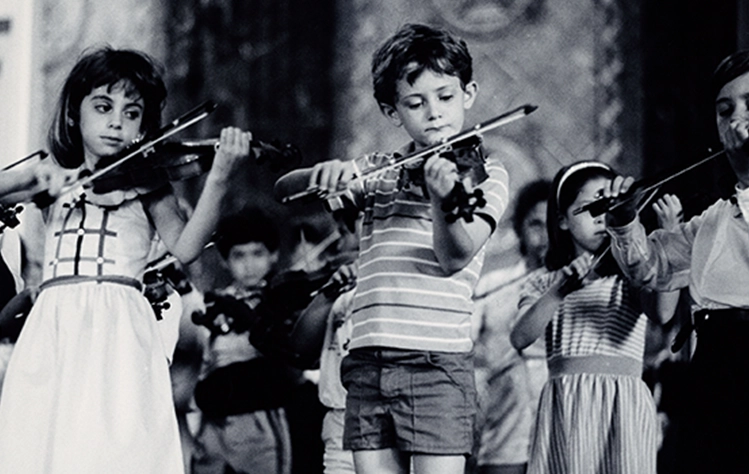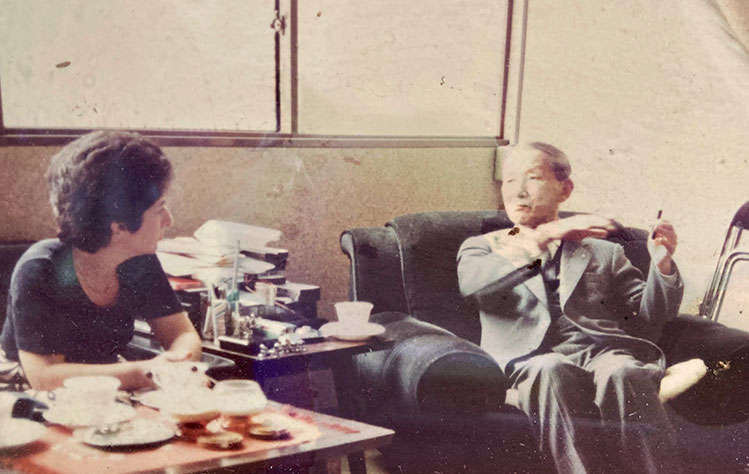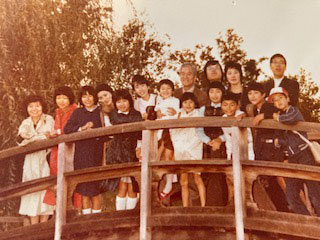Nurturing Talent, Building Community: The Legacy of Suzuki Strings at CMS
April 25, 2025
 CASA (now CMS) Suzuki Students in 1989
CASA (now CMS) Suzuki Students in 1989
Research by Linda Chickos; Draft by China Thomas
The Suzuki Strings program at the Community Music School (CMS) is built on the groundbreaking teaching philosophy of Dr. Shinichi Suzuki, an influential violinist and educator born in Nagoya, Japan, in 1898.
Suzuki, the son of a violin maker, initially taught himself to play the violin by imitating recordings of renowned artists like Mischa Elman and Fritz Kreisler. He eventually pursued formal violin studies in Berlin, where he encountered the rich traditions of European classical music.
Suzuki's revolutionary teaching approach stemmed from his observation of how children naturally acquire language through immersion, repetition and encouragement. This realization inspired him to create the "Mother-Tongue Method," which applied similar principles to music education. His philosophy emphasized the potential of every child to develop ability, given the right environment, encouragement and support.
The Suzuki Method diverges from traditional music instruction by emphasizing learning by ear before reading music, a process akin to how children learn to speak before they learn to read. Suzuki also believed that parents play a crucial role in their child's musical journey, working alongside them to foster growth and confidence. His approach was not about producing prodigies but cultivating a love for music and the character-building benefits it brings, such as discipline, empathy and perseverance.
 Rose Martin and Dr. Shinichi Suzuki in 1983
Rose Martin and Dr. Shinichi Suzuki in 1983
One of CMS’s longtime Suzuki violin instructors and first coordinator, Rose Martin, played a vital role in shaping the program. Martin joined the Suzuki Strings faculty in 1976 and taught for 46 years before retiring, leaving behind a profound legacy.
A Suzuki cello program under Mary Lou Gotman was added several years after the violin program. In 1983, Martin traveled to Matsumoto, Japan, to work directly with Suzuki, at a time when his influence was beginning to take deeper root in the U.S. Under her leadership, CMS became a gathering place for authentic Suzuki teaching, hosting workshops with Eiko Kataoka, a former student of Dr. Suzuki and a member of the St. Louis Symphony, as well as Dr. John Kendall, the violin professor from Southern Illinois University Edwardsville who first introduced the Suzuki Method to the United States.
The CMS Suzuki program has also benefited from the leadership of Susan McDonald, who joined the CMS in 1985 and became the Suzuki Coordinator in 1989. A Registered Teacher Trainer for the Suzuki Association of the Americas (SAA), McDonald has worked with Suzuki programs nationwide and has served on the Board of Directors of the SAA. Under her guidance, the program has continued to flourish, with four full-time Suzuki instructors, two part-time instructors and over 120 students enrolled in the 2024-2025 academic year.
At CMS, Suzuki String Program parents continue to actively participate in their children’s learning, practicing alongside them and attending lessons as partners. Group lessons and recitals create a shared learning experience, fostering camaraderie and mutual inspiration among students and their families.
From its humble beginnings with just 10 students in Martin’s first class, the Suzuki Strings program at CMS has grown into a thriving program that remains a cornerstone of the Community Music School. It embodies Suzuki’s vision that “any child can be educated” to reach their potential with dedication, encouragement and love.
The program’s enduring legacy at CMS is one of community, collaboration and an unwavering commitment to helping every child discover the joy and beauty of music.
 CASA (now CMS) students play for Japanese Tour Group in 1983.
CASA (now CMS) students play for Japanese Tour Group in 1983.
 Japanese Tour Group at the Missouri Botanical Garden in 1983
Japanese Tour Group at the Missouri Botanical Garden in 1983
